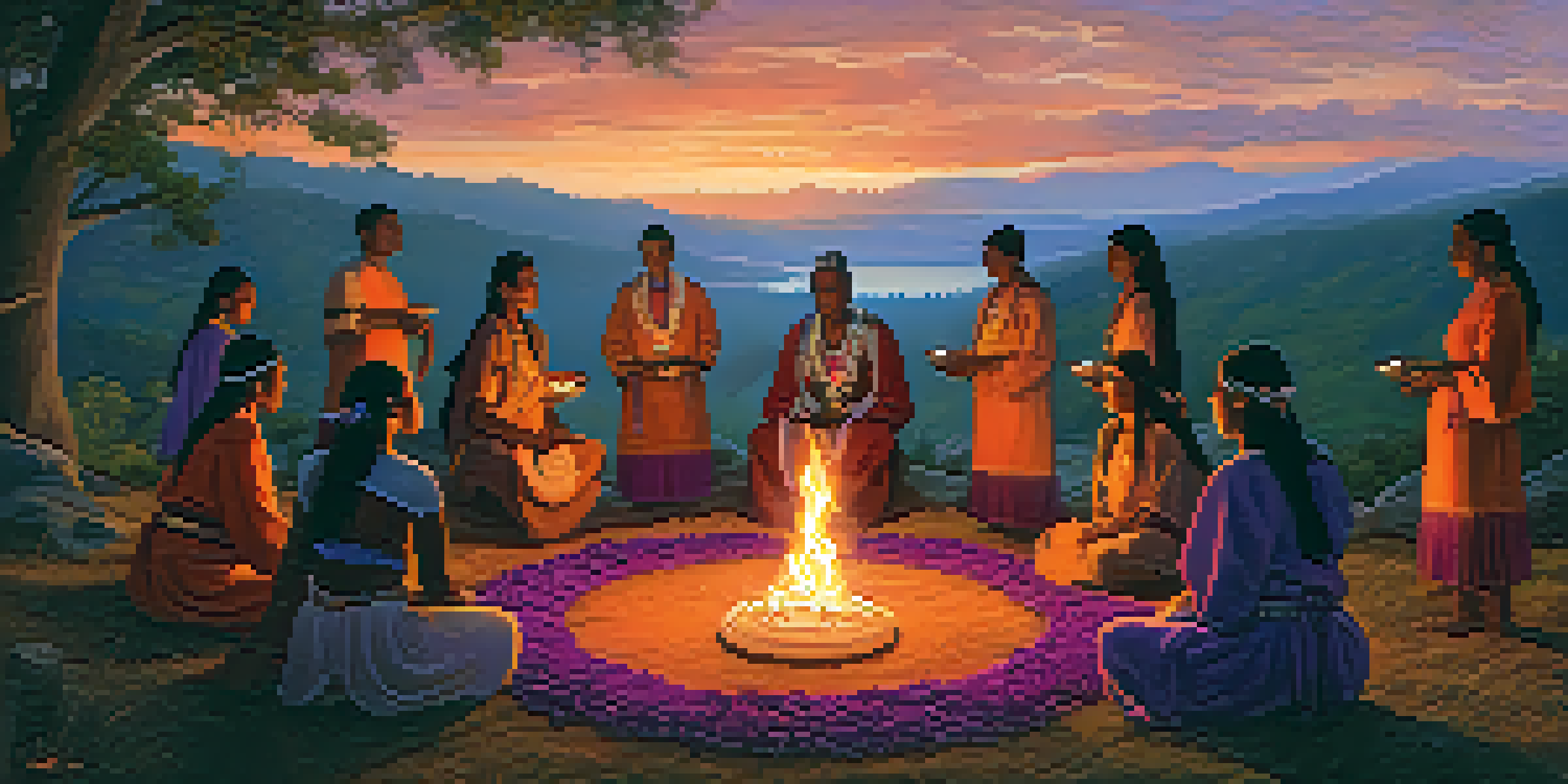Entheogenic Practices Among Indigenous Tribes

Understanding Entheogens and Their Cultural Significance
Entheogens, derived from the Greek words meaning 'generating the divine within,' refer to psychoactive substances used in spiritual or religious contexts. Many indigenous tribes incorporate these substances into their rituals, believing they facilitate a deeper connection with the spiritual realm. For these communities, entheogens are not merely tools for altered states of consciousness; they are sacred elements that enrich their cultural identity and spiritual practices.
The only way to make sense out of change is to plunge into it, move with it, and join the dance.
These substances can vary widely, from peyote in Native American traditions to ayahuasca in Amazonian cultures. Each tribe has its unique approach, but the underlying theme remains the same: these practices are viewed as pathways to greater understanding, healing, and community bonding. Engaging with entheogens is often a communal experience, fostering unity among participants as they navigate their spiritual journeys together.
Moreover, the use of entheogens is steeped in tradition, often passed down through generations. This emphasizes the importance of respecting these practices and understanding their role in the tribes' worldviews. It’s not just about the experience; it’s about honoring the ancestors and the teachings that come with these potent substances.
Historical Roots of Entheogenic Practices
The use of entheogens among indigenous tribes can be traced back thousands of years. Archaeological evidence suggests that ancient cultures utilized these substances in rituals aimed at connecting with the divine and understanding the universe. For instance, cave paintings in regions like the Sahara depict figures that appear to be in altered states, hinting at the deep-seated history of these practices.

As societies evolved, so did their relationship with entheogens. Many tribes developed complex rituals surrounding their use, often including songs, dances, and storytelling to enhance the experience. These practices were not arbitrary; they served specific purposes, such as healing, divination, or rites of passage, each crafted to fit the tribe's unique cultural context.
Entheogens Connect Spirituality
Entheogens are seen as sacred tools in indigenous cultures, enhancing spiritual experiences and community bonding.
Understanding the historical roots of these practices allows us to appreciate their significance in modern times. Many contemporary movements are seeking to revive these ancient traditions, emphasizing the importance of cultural preservation and respect for indigenous knowledge systems. The historical context enriches our understanding of why these practices endure today.
The Role of Shamans and Spiritual Guides
In many indigenous cultures, shamans or spiritual guides play a crucial role in the administration of entheogenic practices. These individuals are often seen as intermediaries between the earthly and spiritual realms, possessing specialized knowledge about the substances and their effects. Their guidance is essential in navigating the intense experiences that entheogens can provoke.
Indigenous people have the right to maintain and develop their distinct identities and characteristics, and to pursue their development in keeping with their own needs and aspirations.
Shamans often undergo extensive training to prepare for their roles, learning not only the pharmacological aspects of the substances but also the spiritual and cultural significance behind them. This preparation allows them to facilitate safe and meaningful experiences for participants, ensuring that rituals are conducted with respect and care.
Furthermore, the relationship between shaman and participant embodies a deep trust. This connection is fundamental, as the shaman helps individuals interpret their experiences and integrate insights gained during the journey. It's a sacred bond that enhances the overall impact of the practice, making it transformative on both personal and communal levels.
Rituals and Ceremonies: A Communal Experience
Rituals involving entheogens are often communal events, fostering a sense of belonging and shared purpose. Whether it's a sweat lodge ceremony or an ayahuasca retreat, these gatherings are designed to bring participants together in a supportive environment. The collective experience enhances individual journeys, as participants share insights and support one another through emotional and spiritual challenges.
During these ceremonies, various elements come into play—music, dance, and storytelling all contribute to the atmosphere. Drumming and chanting can help participants enter a deeper state of consciousness, while storytelling serves to ground the experience in cultural narratives. These elements remind participants that they are part of something larger than themselves, connecting them to their ancestors and the natural world.
Shamans Guide Transformative Journeys
Shamans play a vital role as trusted guides in entheogenic practices, helping participants navigate intense spiritual experiences.
Additionally, the communal aspect of these rituals can lead to profound healing. Participants often report feelings of unity and love, breaking down barriers between individuals and fostering a sense of collective healing. This shared experience can be pivotal in transforming personal struggles into communal strengths, reinforcing the importance of community in indigenous cultures.
Healing and Therapeutic Benefits of Entheogens
Entheogenic practices have gained recognition for their potential therapeutic benefits, especially in treating mental health issues like PTSD, anxiety, and depression. Indigenous tribes have long understood the healing properties of these substances, using them to facilitate emotional release and introspection. Their approach often emphasizes holistic healing that addresses the mind, body, and spirit.
Research into these practices has revealed that, when guided appropriately, entheogens can lead to significant psychological breakthroughs. Participants often report a sense of clarity and connection to their emotions, enabling them to process trauma and grief. This therapeutic aspect is increasingly being explored in clinical settings, drawing from the wisdom of indigenous practices to inform modern mental health treatments.
However, it's essential to approach this area with caution and respect. The therapeutic use of entheogens should always be conducted in a safe, controlled environment, ideally under the guidance of trained professionals. This ensures that the ancient wisdom of indigenous practices is honored while adapting their insights to contemporary therapeutic frameworks.
Contemporary Revival and Cultural Appropriation Issues
In recent years, there has been a resurgence of interest in entheogenic practices, with many people seeking to experience these traditional ceremonies. However, this revival raises important questions about cultural appropriation. Many indigenous communities feel that outsiders often misinterpret or exploit their sacred traditions without understanding their significance.
Cultural appropriation occurs when elements of one culture are taken by another, often without permission or respect for their original context. This can lead to the commodification of spiritual practices that hold deep meaning for indigenous tribes. It's crucial for those interested in these practices to approach them with humility, seeking to understand and respect the cultural backgrounds they stem from.
Cultural Respect in Modern Practices
As interest in entheogens grows, it's crucial to engage respectfully with indigenous traditions to avoid cultural appropriation.
Engaging with entheogenic practices in a respectful manner involves acknowledging their origins and supporting indigenous communities. This can include participating in ceremonies led by indigenous leaders, promoting cultural preservation efforts, and advocating for the rights of these communities. By doing so, we can foster a deeper understanding and appreciation of these rich spiritual traditions while respecting their cultural integrity.
The Future of Entheogenic Practices in Indigenous Communities
As the interest in entheogenic practices continues to grow, indigenous communities face both opportunities and challenges. On one hand, this revival can lead to greater recognition of their cultural heritage and potential economic benefits through responsible tourism. On the other hand, there is a risk of dilution or misrepresentation of their practices in the broader context.
Many indigenous leaders are advocating for the preservation of their traditions while also educating outsiders about the importance of respectful engagement. This involves creating spaces for dialogue and collaboration, allowing indigenous voices to lead the conversation about how their practices are shared and experienced. The goal is to ensure that these practices remain authentic and meaningful within their cultural context.

Looking ahead, it’s vital to support indigenous rights and sovereignty over their cultural practices. As awareness grows, so does the potential for positive change—one that honors the wisdom of these communities while allowing for the respectful sharing of their knowledge. The future of entheogenic practices lies in collaboration, respect, and an unwavering commitment to cultural integrity.